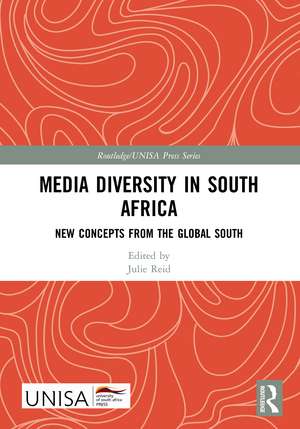Media Diversity in South Africa: New Concepts from the Global South: Routledge/UNISA Press Series
Editat de Julie Reiden Limba Engleză Paperback – 26 aug 2024
Disappointingly, research shows that most South African citizens (most of whom are economically marginalised) are found to experience extremely low levels of media content diversity in their personal media diets. The contributing factors are inter-related and complex, but include the inequitable distribution of media content, a lack of African language media, and most especially, the cost of media access which is unaffordable to many. In this book, the authors examine what went wrong with post-apartheid attempts to democratise the media landscape, and why the experienced levels of media diversity by the majority South African audience remain so woefully low. While media diversity is usually measured by policymakers, sector stakeholders or by market-related imperatives, this book foregrounds the perspective of the media consumer. In doing so, traditional media measuring is inverted – leading to a more in-depth understanding of how ordinary people in the Global South receive media content, how much, and why.
The authors offer a holistic analysis of the ineffectuality of key media policymaking processes, projects and institutions – while also suggesting how these could be transformed to create a more diverse and broadly accessible media landscape.
Din seria Routledge/UNISA Press Series
-
 Preț: 355.88 lei
Preț: 355.88 lei - 12%
 Preț: 312.06 lei
Preț: 312.06 lei - 16%
 Preț: 264.12 lei
Preț: 264.12 lei -
 Preț: 386.00 lei
Preț: 386.00 lei -
 Preț: 388.72 lei
Preț: 388.72 lei -
 Preț: 379.68 lei
Preț: 379.68 lei -
 Preț: 390.63 lei
Preț: 390.63 lei -
 Preț: 378.87 lei
Preț: 378.87 lei - 18%
 Preț: 1004.38 lei
Preț: 1004.38 lei - 18%
 Preț: 1012.34 lei
Preț: 1012.34 lei -
 Preț: 387.38 lei
Preț: 387.38 lei -
 Preț: 390.63 lei
Preț: 390.63 lei - 18%
 Preț: 998.83 lei
Preț: 998.83 lei - 18%
 Preț: 1004.55 lei
Preț: 1004.55 lei - 18%
 Preț: 1002.99 lei
Preț: 1002.99 lei - 5%
 Preț: 1157.60 lei
Preț: 1157.60 lei -
 Preț: 395.47 lei
Preț: 395.47 lei - 14%
 Preț: 261.14 lei
Preț: 261.14 lei -
 Preț: 384.27 lei
Preț: 384.27 lei
Preț: 386.00 lei
Nou
Puncte Express: 579
Preț estimativ în valută:
73.88€ • 80.28$ • 62.10£
73.88€ • 80.28$ • 62.10£
Carte tipărită la comandă
Livrare economică 21 aprilie-05 mai
Preluare comenzi: 021 569.72.76
Specificații
ISBN-13: 9781032101866
ISBN-10: 1032101865
Pagini: 218
Ilustrații: 16
Dimensiuni: 174 x 246 mm
Greutate: 0.37 kg
Ediția:1
Editura: Taylor & Francis
Colecția Routledge
Seria Routledge/UNISA Press Series
Locul publicării:Oxford, United Kingdom
ISBN-10: 1032101865
Pagini: 218
Ilustrații: 16
Dimensiuni: 174 x 246 mm
Greutate: 0.37 kg
Ediția:1
Editura: Taylor & Francis
Colecția Routledge
Seria Routledge/UNISA Press Series
Locul publicării:Oxford, United Kingdom
Public țintă
Academic, Postgraduate, and Undergraduate AdvancedCuprins
CHAPTER 1: Conceptualising a new understanding of media diversity Julie Reid CHAPTER 2: Measuring media diversity in South Africa: a model for measuring media diversity and the audience centred approach Julie Reid and Vanessa Malila PART B Reaching and researching the audience CHAPTER 3: The lay of the media landscape: media ownership concentration in South Africa Petrus Potgieter and George Angelopulo CHAPTER 4: But how much news do we really get? Actual access to the news media among different audiences in South Africa George Angelopulo and Petrus Potgieter CHAPTER 5: An audience study on experienced levels of news media diversity among low-income media users in South Africa Vanessa Malila and Julie Reid PART C Media policy and sectors in South Africa: what about diversity? CHAPTER 6: Policy choice or policy convergence? The media and Information and Communications Technologies (ICTs) policies of South Africa’s major political parties Jane Duncan CHAPTER 7: Lofty ideals but a failing mission. The Media Development and Diversity Agency Tanja Bosch CHAPTER 8: Frenemies: Toward an ethnography of audience engagement with public service television in South Africa viola c. milton CHAPTER 9: Missed opportunities for substantive diversity. Media diversity and digital terrestrial television in South Africa Kate Skinner CHAPTER 10: Community newspaper voices: local and black, but the glaring gap is women Glenda Daniels CHAPTER 11: Reflections on the African digital ecosystem viola c. milton INDEX
Notă biografică
Julie Reid is an Associate Professor at the Department of Communication Science at the University of South Africa (UNISA).
Descriere
This timely book argues that the Global North’s research methods and traditional assumptions are not valid to the media landscapes and audiences of the Global South. With South Africa as the focus, the authors offer a new understanding of media diversity along an audience-centred approach.
